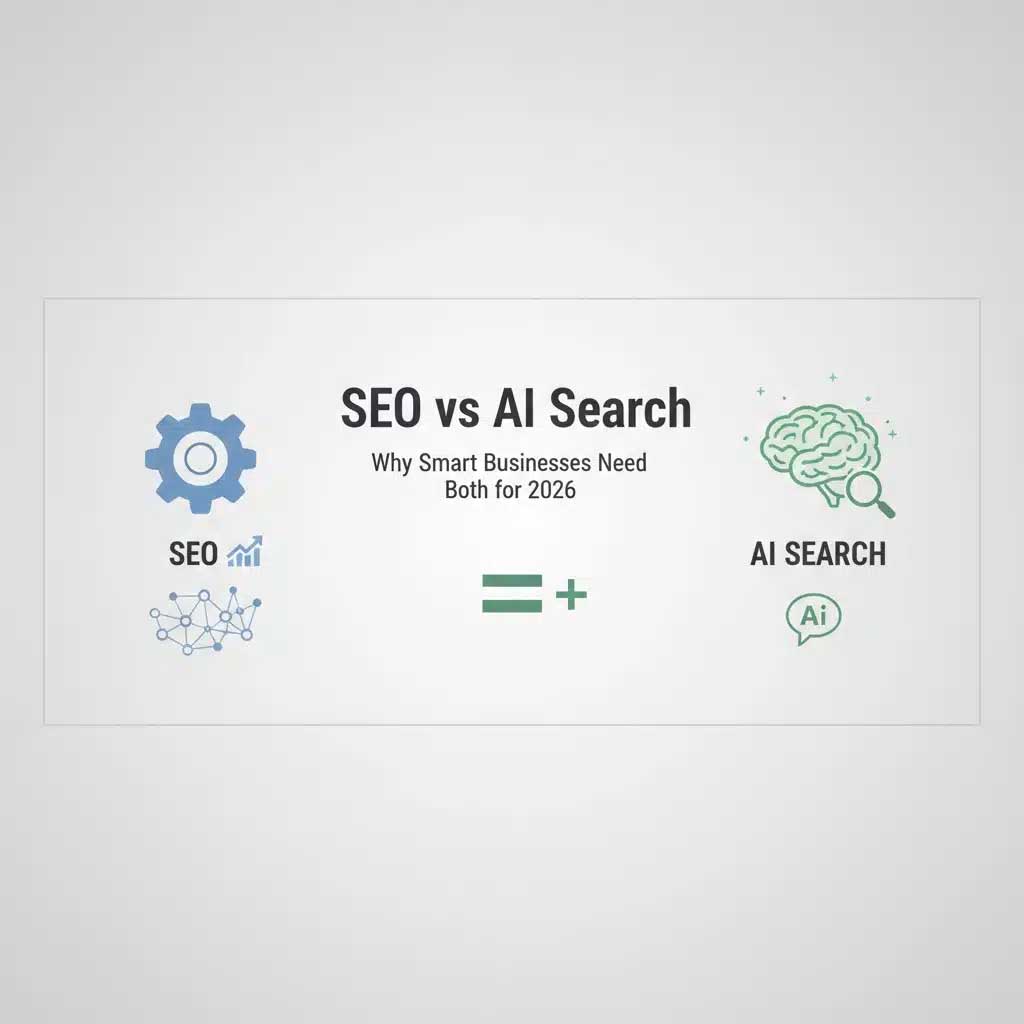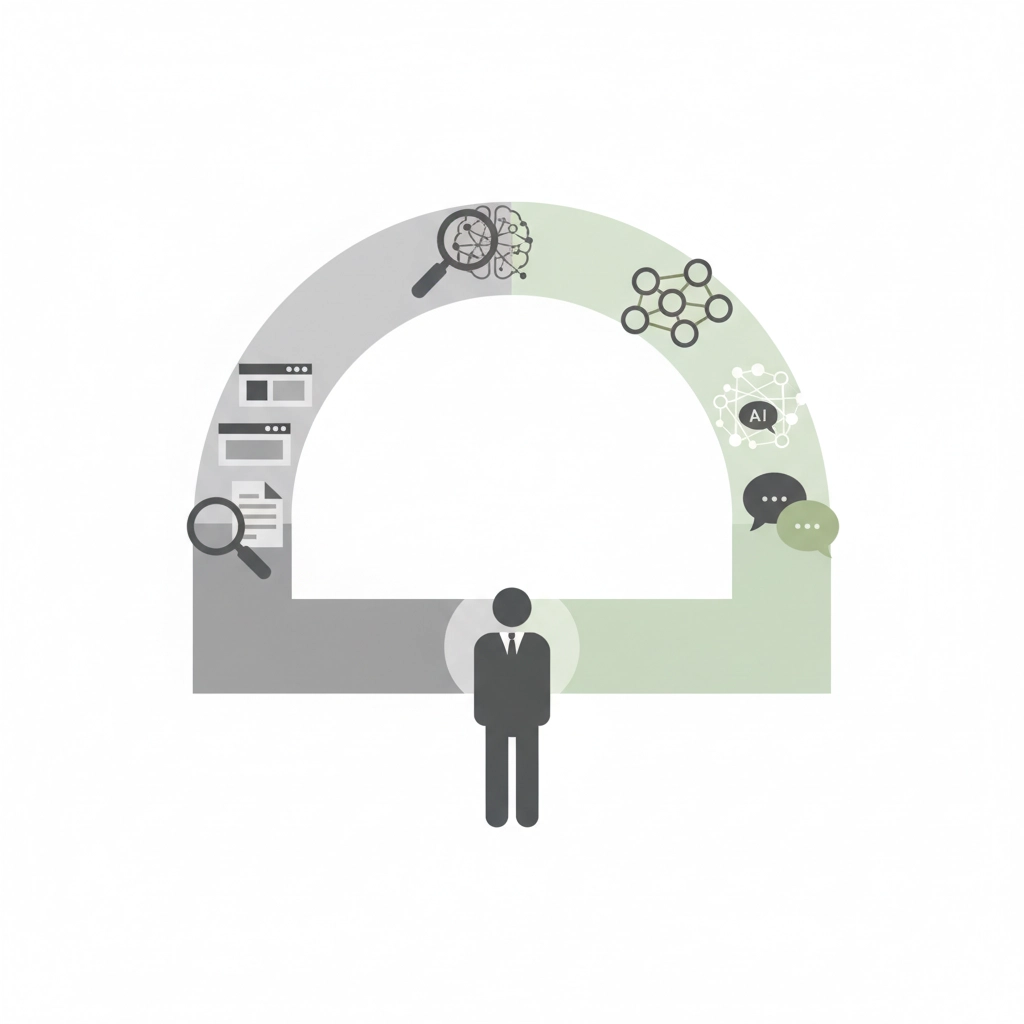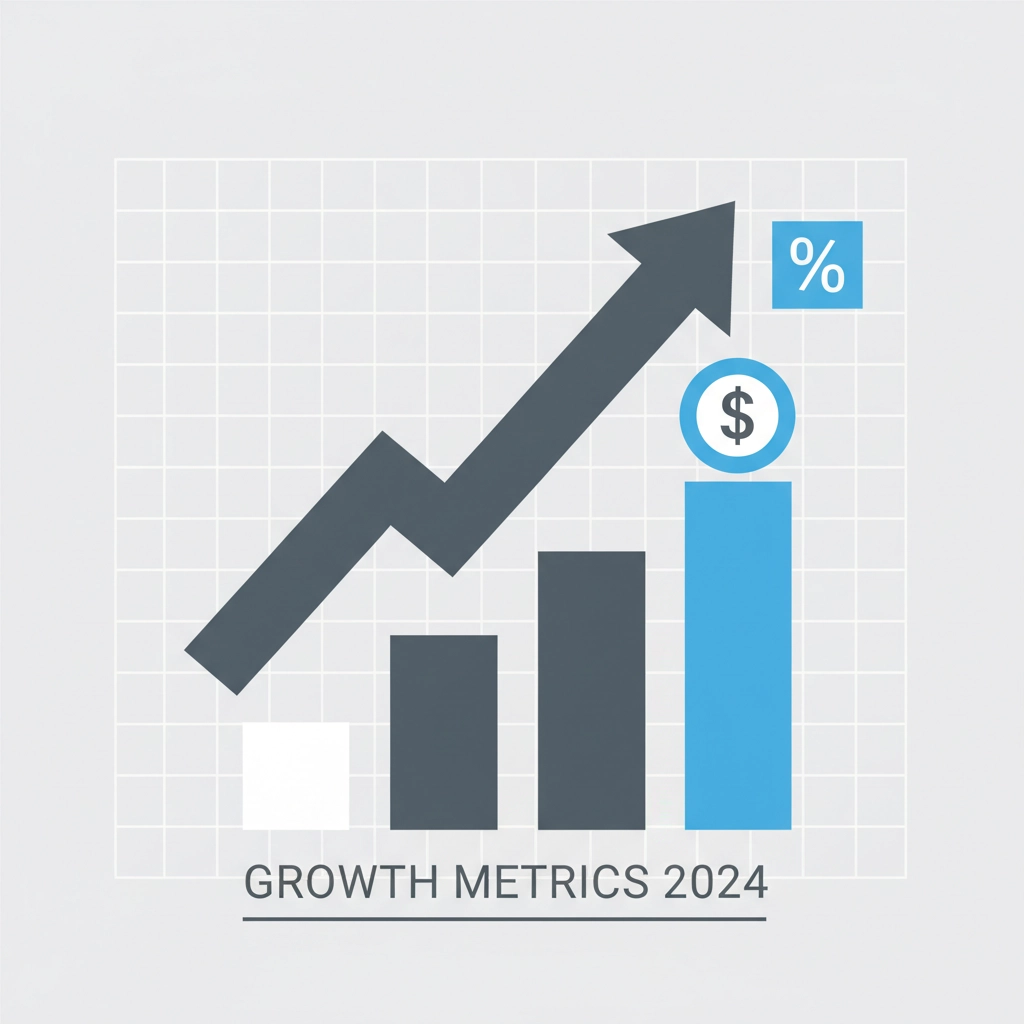The search landscape has fundamentally shifted, but here's what most business owners get wrong: you don't choose between traditional SEO and AI search optimization: you master both. While 88% of search traffic still flows through traditional search engines, AI search traffic has exploded 527% in just one year. Your customers aren't abandoning Google for ChatGPT; they're using both platforms within the same research session, often within minutes of each other.
This creates a critical imperative for 2026: businesses must develop integrated search strategies that capture visibility across all discovery channels. The companies that understand this dual-channel reality will dominate their markets, while those clinging to outdated "SEO-only" approaches will watch their visibility evaporate as search behavior continues to evolve.
The Numbers Don't Lie: Search is Diversifying, Not Disappearing
Traditional search engines maintain their stranglehold on discovery, commanding 88% of all search traffic and driving at least 43% of ecommerce traffic. Organic search alone accounts for 23.6% of all ecommerce sales: a massive revenue stream that remains largely untapped by businesses focusing exclusively on paid advertising.
But here's where it gets interesting: Google AI Overviews now reach 2 billion monthly users, and nearly 60% of Google searches in 2024 ended with zero clicks. Users found what they needed directly on the search results page through AI-generated summaries and featured snippets. Meanwhile, ChatGPT reached 100 million users in just two months: the fastest app adoption in history.
Industry projections suggest website traffic from AI search platforms may actually surpass traditional search traffic by 2028. This isn't speculation: it's mathematical inevitability based on current adoption curves. The question isn't whether this shift will happen, but whether your business will be positioned to benefit from it.
The Three-Pillar Framework: SEO, AISO, and GEO
Modern search visibility requires mastering three distinct but interconnected optimization strategies. Each serves a different function in the customer discovery journey:
SEO (Search Engine Optimization) remains your volume engine. It captures the massive search traffic flowing through Google, Bing, and other traditional platforms. SEO focuses on achieving prominent SERP positions, particularly page one rankings that drive brand awareness and initial discovery. This isn't going away: it's your foundation for reaching customers who don't yet know your brand exists.
AISO (Artificial Intelligence Search Optimization) transforms your content into instant answers. Instead of competing for clicks, AISO positions your content to appear in AI-generated responses, voice search results, and featured snippets. When users search for information, your content provides the immediate answer they need. The advantage: users who do click through from AI results are significantly more qualified and ready to engage with your services.
GEO (Generative Engine Optimization) ensures AI platforms cite your content when generating comprehensive answers. As tools like ChatGPT, Google Gemini, and Perplexity pull information from multiple sources to create responses, GEO makes your content the authoritative source they reference. This strategy focuses on comprehensive topic coverage, demonstrating expertise across entire subject areas rather than individual keywords.
Why the "Either-Or" Approach Kills Growth Potential
Business owners who view SEO and AI search as competing strategies fundamentally misunderstand modern consumer behavior. Your customers don't care about your optimization philosophy: they seamlessly move between search platforms based on their immediate needs.
Neglecting traditional search engines sacrifices discovery volume. Search remains the primary engine for introducing potential customers to your category and brand. Most ecommerce discovery and initial brand awareness still flows through conventional search channels. Without strong SEO foundations, you're invisible to customers in the early stages of their buying journey.
Conversely, neglecting AI search sacrifices conversion efficiency. AI-powered tools act as sophisticated filters, eliminating casual browsers and window shoppers. Users who engage with AI-generated citations are typically further along in their decision-making process and more ready to convert into paying customers.
The most successful businesses are capturing high-intent customers through AI search while maintaining discovery volume through established search channels. This creates a robust customer acquisition system that doesn't depend on any single traffic source: critical for long-term business stability.
Content Strategy That Wins Across All Channels
Optimizing for both traditional and AI search doesn't require creating duplicate content or running parallel campaigns. Instead, it demands producing high-quality, comprehensive resources that serve both human readers and AI systems.
Content that performs across all search environments must be genuinely authoritative. Shallow blog posts and keyword-stuffed pages are increasingly ignored by both search algorithms and AI platforms. Instead, focus on creating definitive guides that answer primary questions and anticipated follow-ups with original research, concrete examples, and actionable insights.
Structure matters equally for both optimization types. Well-organized content using clear headings, bullet points, schema markup, and logical hierarchies helps search engines index properly while enabling AI systems to extract and cite information accurately. Featured snippets that benefit AISO still drive clicks when users want detailed information beyond the brief answer, supporting long-term brand visibility and trust-building.
The key insight: content hubs that capture traditional long-tail search traffic while simultaneously positioning themselves for AI citations eliminate the need to choose between optimization strategies. You're creating resources that work harder across multiple discovery channels.
Measurable ROI From Integrated Approaches
The business case for integrated search strategies is backed by compelling data. Nearly 70% of businesses report higher ROI from incorporating AI into their SEO processes. This improvement stems primarily from increased speed and scale: AI tools accelerate topic research, content creation, and publishing workflows, allowing teams to focus more time on strategy and optimization rather than execution.
More importantly, businesses using integrated approaches report better visibility metrics across all search platforms. Instead of optimizing twice for different channels, successful strategies create comprehensive content that naturally performs well in traditional search rankings while earning citations from AI platforms.
Companies implementing this approach see increased organic traffic from traditional search engines alongside growing referral traffic from AI platforms. This diversification reduces dependence on any single traffic source while maximizing the total addressable market for customer discovery.
Technical Foundations That Support Both Strategies
Successfully optimizing for both traditional and AI search requires solid technical foundations. Your website must be fast, mobile-accessible, and properly indexed by search engines. These technical elements benefit both SEO and AI optimization since AI platforms often reference well-structured, easily accessible content.
Schema markup becomes particularly important in this integrated approach. Structured data helps search engines understand your content while making it easier for AI systems to extract relevant information for citations. Implementing comprehensive schema markup: including FAQ schemas, article schemas, and local business markup where appropriate: supports visibility across all search environments.
Site architecture and internal linking also play crucial roles. Clear navigation and logical content hierarchies help both search engine crawlers and AI systems understand your content relationships. When our team works with businesses on SEO strategy optimization, we always prioritize these technical foundations because they amplify the effectiveness of all other optimization efforts.
Preparing Your Business for 2026 and Beyond
The businesses that will dominate their markets in 2026 are adapting early to this expanded search ecosystem. They maintain strong technical SEO foundations while building the content authority and expertise that earns AI citations.
This preparation involves auditing your current content for opportunities to expand shallow posts into comprehensive resources. It means identifying topic gaps where your competitors haven't yet established authority. Most importantly, it requires developing content creation workflows that naturally optimize for both traditional search rankings and AI platform visibility.
The fundamental reality is straightforward: customer discovery is diversifying across multiple channels, and your strategy must reflect this reality. Your competitors who understand this shift are already building integrated approaches while others debate whether "SEO is dead." The companies that act quickly will establish dominant positions across all search channels before the competition catches up.
Understanding how to handle algorithm volatility becomes even more critical as search continues evolving. Diversified visibility strategies provide protection against changes in any single platform while maximizing growth opportunities across the expanding search ecosystem.
The question isn't whether search will continue evolving: it's whether your business will be positioned to benefit from that evolution. Smart businesses are building integrated search strategies now, capturing market share while their competitors remain paralyzed by false choices between traditional and AI search optimization.
Ready to future-proof your search strategy for 2026? Our team specializes in developing integrated SEO and AI search approaches that maximize visibility across all discovery channels. Book a consultation to discuss how we can help your business dominate both traditional and AI search results.










